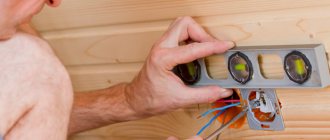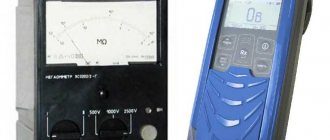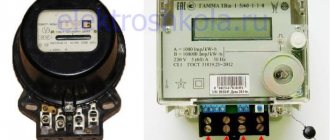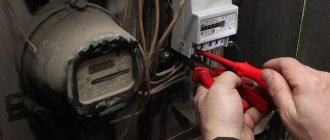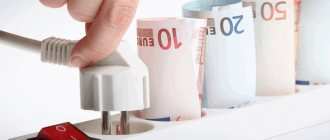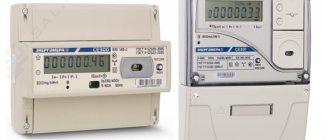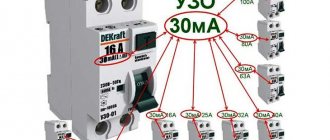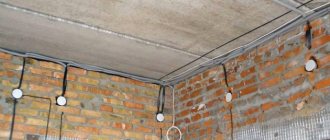Types of electricity meters
The legislation provides for equipping all residential and non-residential buildings with electricity meters; responsibility for this lies with the owner of the premises.
For the convenience of the population, various device options are offered:
- Mechanical or induction. Quite widespread, as they were installed everywhere over a long period of time. They are distinguished by their reliability and durability, but at the moment such IPUs are gradually losing popularity due to their low accuracy class. The principle of operation is the formation of a magnetic field between two coils, which causes the counting mechanism to rotate.
- Electronic. Modern devices guarantee extreme accuracy, since measuring current and voltage does not require the presence of a magnetic field, which eliminates losses. Such an electric meter has many advantages, but in case of failures and fluctuations it can fail.
There are types of IPU depending on the type of nutrition:
- Single-phase. The most common option, suitable for residential and small domestic premises. Mounted on two-wire networks with a standard voltage of 220 volts.
- Three-phase. They are used for technical and industrial facilities, as well as private houses and apartments equipped with powerful electrical appliances. Suitable for three- and four-wire networks with a voltage of 380V.
In the vast majority of cases, private houses and city apartments are equipped with single-phase electricity meters; the use of three-phase metering devices is allowed with a large potential load and a housing area of 100 m² or more
To save money, the following types of electricity meters have been developed:
- Single tariff. Standard option, which takes into account consumption around the clock at a single price.
- Multi-tariff. They are divided into zones according to the time of day: two-tariff and three-tariff. When using electricity at night, significant savings are achieved, but during peak hours the tariff is maximum.
Read more about which electricity meter is best to install in an apartment.
You should know! Service organizations cannot force the owner of the premises to install an IPU, but in this case the payment is calculated according to the standard with an increasing coefficient, which leads to the accrual of significant amounts.
Recommendations
induction (electromechanical) electricity meters
Compared to modern ones, they do not require expensive maintenance and are definitely more reliable.
So far they have not been surpassed in reliability and ability to work and function without breakdowns. In Europe, where most of the meters are electronic, over time, they again began to show interest in unpretentious and reliable electromechanical devices.
In any case, no matter what device is chosen, you should make sure that the seal is intact and undamaged. There is also an expiration date for fillings:
- for single-phase – 2 years
- for three-phase – 1 year.
It is recommended to install the meter as close to the entry point as possible. The meter must be located in a warm room, this can be a heated or insulated hallway, where the company employees will have easy access to the device.
If the company requires that household meters be installed on the facade of the house, if it was not possible to get the requirement lifted, you can cheat a little and place the meter where the warm terrace will subsequently be built.
You may also be interested in an article about three-tariff electricity meters.
Read an article on how to properly seal an electric meter here.
Watch the video in which a specialist explains the requirements for installing an electricity meter in a private home, as well as the general rules for operating electricity meters:
Installation Rules
Installation and connection of the electricity meter is carried out in accordance with the recommendations prescribed in the PUE:
- The room must be dry. If you plan to place it on a pole or the facade of a building, then the device must be marked that it is suitable for outdoor installation at temperatures down to –40 degrees.
- Height from the floor - from 80 to 170 cm. Placement below 0.8 m is allowed, but subject to a 40 cm indentation.
- The mechanism and additional elements are placed in a shield or special box. All parts must be well recorded.
- When connecting an electric meter, you must exclude any illegal connections that could be made to the installation site of the device.
- It is recommended to leave a supply of live wires to ensure convenience during replacement or other actions and to eliminate the need for extension.
- Electrical wiring should not be twisted or soldered; in case of increased fragility of the elements, a complete replacement of the supply section is required.
- The IPU is placed strictly horizontally; distortions can lead to malfunction.
- All wires are marked or connected according to the accepted color identification.
The installation height of the meter indoors and the installation level of the cabinet with the meter outdoors are absolutely the same, the difference lies in the presence or absence of a protective box
Existing requirements must be observed; deviations from the rules that affect operation and safety will result in the impossibility of putting the device into operation.
Connection diagram for the meter, regardless of its location
When installing a water meter, you must adhere to the standard scheme so that its readings are as accurate as possible. It provides for the installation of additional elements, such as a coarse filter and a check valve.
The filter is necessary in order to stop any large particle that accidentally gets into the water supply and can jam the meter impeller. If this happened, it would be necessary to undergo verification prematurely or completely change the meter, which not every home owner will like.
A check valve is used to prevent distortion of readings in any emergency situation. During a loss of pressure in the main pipe, negative pressure can form, which is why air will begin to be sucked through the meter, in fact “rewinding” it in the opposite direction. However, this would lead to losses on the part of the water supply company. Therefore, the check valve is a mandatory element to ensure correct operation of the meter.
Installation location
For the placement of electrical power supply units, there are standards that regulate the procedure.
Multi-storey building
Such buildings are built in compliance with many technical rules, which guarantees a convenient and safe supply of electricity. A special panel room on the landing is allocated for metering devices.
In modern apartment buildings, IPUs are most often installed directly in the apartment. This not only allows the owner to control the readings, but also ensures the safety of the mechanism, for which the homeowner is responsible.
Private or country house
The most common option for placing an electric meter is a pole from which wires for connection are drawn, which limits the possibility of illegal connection. But since the place is located on the street, ensuring the safety of the device becomes difficult.
It is possible to install the device in a protective box on a special pipe stand or pole in a fenced area. The installation site should not be cluttered or difficult to access.
The law does not prohibit installing an electric power supply directly in the premises, which is especially important for a seasonally visited summer house or a private house that was previously equipped with an electric meter inside. But approval of such work may require going to court, which does not always side with the owner.
Garage
If there is energy-intensive equipment at the facility, a three-phase meter is installed. If the room is used only for storing a vehicle or some things, then single-phase is sufficient.
The placement order depends on the specific situation. Installation of the IPU on the street is allowed: a nearby pole or a special structure is suitable for this. Internal fixation is carried out according to standard connection requirements.
On a note! It is important to ensure unhindered access to the electric energy meter for representatives of the service organization; the protective box should be easy to open for inspection.
Type of devices
First, let's briefly understand what types of electricity meters there are, after which we will find out which one is needed for a house, apartment and cottage.
So, today there are the following types of metering devices:
- Induction (mechanical) and electronic. The first ones are classics of the genre and are still used in buildings of the old type. The advantage of induction electricity meters is durability, reliability and low price. At the same time, the main disadvantage is the low accuracy class, as a result of which you can either overpay extra money or underpay. In turn, electronic metering devices are multifunctional, can be designed for several tariffs, and are also better in that they take up less space on the input panel. As you understand, the disadvantage is the higher cost and shorter service life, which discourages buyers. You need to choose the type of meter based on your financial capabilities. We talked about how one and the other option works in the article: https://samelectrik.ru/kak-rabotaet-schetchik-elektroenergii-starogo-i-novogo-obrazca.html.
- Single-tariff and multi-tariff. There has already been a whole discussion here among owners of meters with two/three tariffs and ordinary single-tariff meters. We have already looked at the advantages of two-tariff meters, where we provided both negative and positive customer reviews. We repeat once again that the rationality of choosing an electric meter for several tariffs depends on the region of residence and on what household appliances you use more often. If you have a nocturnal rhythm of life, it is better to choose and buy a multi-tariff meter for your home and apartment.
- Single-phase or three-phase. Everything is simple here and the choice of meter depends on the type of power supply to your home or apartment - single-phase or three-phase.
- Accuracy class. This characteristic shows the percentage error of the electricity meter when accounting for electricity consumption. Today, it is necessary to use devices with an accuracy class of no lower than 2.0 (according to Decree of the Government of the Russian Federation dated May 4, 2012 N 442 (as amended on June 22, 2019), see Rules for organizing electricity metering in retail markets. p. 138 ). The more accurate the accounting, the less likely it is to be deceived when paying for light.
- Power. Another equally important characteristic that must be taken into account when choosing an electricity meter is the total electrical load (power). The electrical products market offers direct connection meters in the current load range from 5 to 100A. We talked about how to determine the power consumption of electrical appliances in a separate article.
- Mounting method. The housing can be mounted either on a DIN rail or with bolts.
- Conditions of use. There are devices intended for use only in heated rooms, and there are outdoor models. Meters must be operated under the conditions specified in the metering device's passport.
A short video review on choosing an electric meter for a home or apartment:
Installation of an electricity meter in a private house
To connect the meter correctly, you must follow the instructions.
Work order
Placing an IPU in a home requires certain skills. It is important to accurately calculate the planned power, which depends on the availability of electrical equipment. Based on this value, the type of device is determined: single- or three-phase.
Stages of approval and installation:
- An application for the need to connect a building to the power grid is submitted to the appropriate organization. The required power is indicated, supported by calculations, and the model and type of electric meter must be included. The authorized person issues a standard contract and provides the technical conditions necessary for connection. Coordination of individual details may be necessary.
- An individual project is drawn up. For these purposes, a specialist from a sales company or a certified company is involved.
- After clarifying all the nuances and obtaining permission, you can install the box and place an individual meter.
- To seal the electricity meter, if installation work is carried out independently or by a third party, you need to call an energy network employee. He will check the connection and, if everything is correct, will seal it and draw up a corresponding report. From this moment the electric meter is considered to be put into operation.
In the absence of experience and skills, it is recommended to involve specialists.
Taking the device outside
At the moment, due to the requirements of Energosbyt to install the meter not inside the premises, but outside, some disagreements are arising. Various location options are available: façade, pillar or specially erected structure.
Representatives of the company refer to Decree of the Government of the Russian Federation of May 4, 2012 No. 442. Indeed, the law states that IPUs must be installed along the border of the balance sheet ownership of the company’s energy networks and the site of the owner of the facility. This territory means the facade of a building or a boundary pillar, so many owners of private houses are required to take the device outside.
But if the owner does not want to change the location of the electricity meter, the owner can appeal to the PEU, which states that the mechanism must be located in a dry room with a temperature not lower than 0 °C. In addition, the consumer is directly responsible for the safety of the IPU, according to the Civil Code of the Russian Federation and RF PP No. 354. Thus, if the owner provides convenient, unobstructed access to the electric meter, there is no need to reinstall it.
You should know! Since the existing requirements contradict each other, if it is impossible to reach a compromise, the owner must contact the regulatory authority, prosecutor's office or court.
Who pays and makes the replacement?
A person authorized under an agreement with the Criminal Code and the existing provisions of the Housing Code and Civil Code is appointed responsible for the acquisition and installation of a new device. However, this takes into account the reason why the replacement is being made, as well as the installation location. For homeowners and people who own an apartment on a rental basis, the rules are different.
Option #1 – own apartment
Most of the city apartments are owned by citizens - at one time housing was privatized, and ownership rights completely passed into the hands of the owners. One or more family members can dispose of the apartment at their own discretion, and they are also responsible for all technical property located in its area.
If the electrical panel with the metering device is apartment-based, that is, located in the hallway or corridor inside the apartment, then the responsibility for installing a new device lies with the private individual
The electricity meter installed on the floor area must be changed by the management company, since it belongs to the common property of the building. Replacement is required if the device has exhausted its resource, is outdated, or breaks down for reasons beyond the control of the consumer.
Responsibility for replacement falls on the apartment owner in three cases:
- if the meter breaks down due to his fault;
- if the contract stipulates in a separate clause its obligations for replacement;
- if he, on his own initiative, wanted to change the equipment.
Simply put, according to standard agreements, apartment panels are the property of the owners, floor panels are the property of the management company. Accordingly, the owners are responsible for any actions with meters.
But there are exceptions that are specified in the contract. So if you are forced to pay for a new device, be sure to review the agreement.
In 2012, a law was passed according to which residents of apartment buildings must independently change meters, regardless of where they are installed. However, the main regulatory document is the agreement between the owners and the management company.
Option #2 – public housing
If the apartment is not privatized, and its owner lives under a social tenancy agreement, all property, including electrical equipment, is the property of the municipality. Therefore, the city is responsible for installing or replacing equipment.
However, in practice, situations often occur when a management company or an energy sales company attracts residents to purchase a new device. This is wrong, since they are temporary employers, users.
Typically, an agreement is concluded between the management company and the municipality with the distribution of responsibilities of the parties. Therefore, in the end, one of them pays for new electrical equipment. If they still try to blame the purchase on the tenant, you must file a complaint with the housing inspectorate
A citizen living on municipal meters pays for the replacement of the meter only in one case - if the device breaks down due to his fault.
Option #3 – private house
Owners of cottages for permanent residence or seasonal houses (dachas), unless there is an additional clause in the agreement with the service organization, almost always bear the cost of replacing the meter themselves.
A metering device in private houses is usually installed together with an input machine on the street - on the facade of the house or on a support supporting an electrical cable, so that an employee of the controlling organization can take readings without disturbing the owners
If you own a home, you must purchase and install a meter yourself. If you plan to do the installation yourself, then commissioning and sealing cannot be done yourself - this must be done by a representative of Energosbyt.
It is also better to ask the specialists of the sales company which type of meter and outdoor box for the flow meter to buy, since the device must best comply with the network parameters and installation conditions.
Do-it-yourself single-phase meter installation
To carry out installation yourself, it is recommended to proceed sequentially.
What will you need?
To work you need to prepare:
- Automatic machines. To shut down in case of an emergency.
- DF or RCD that breaks the circuit during a leak or short circuit.
- Boxing or special cabinet. The option is selected depending on the installation location.
- DIN rails for fixing equipment.
- Adapters, busbars and additional elements for connecting various parts.
- Voltage indicators and limiters.
- Standard set of tools.
- Single-phase electricity meter. The model is selected depending on the situation; devices from the Energomera brand are popular
Carrying out installation work
Installation of equipment and components:
- A box or cabinet is placed in a given place, and parts for hanging are fixed inside. The reliability and rigidity of the structure is checked. It is taken into account that height and accessibility must be respected.
- A two-pole circuit breaker is installed to quickly de-energize the home network. It is installed in front of the IPU, which is stated in the PEU.
- A new metering device is hung on the DIN rail, the evenness and reliability of placement is checked.
- If desired, an RCD is installed. You can skip this step and immediately install single-pole circuit breakers.
- The zero bus is fixed at the bottom of the box, and wires are prepared to create jumpers.
How to connect an electric meter
The equipment must be connected according to the following diagram:
- The supply wire is disconnected and sequentially inserted into the connectors of the two-pole circuit breaker (top). For convenience, you need to use color identification or mark the phase and zero.
- The meter is connected. The order of terminals on the device can be found in the passport.
- A jumper is stretched from the phase contact of the input circuit breaker to the IPU; the connection point on the mechanism is most often located at the very beginning.
- The neutral wire is fixed. It should go from the two-pole machine to the meter terminal (for most products No. 3), but not come into contact with the previous one.
- The phase with the IPU is allocated to single-pole circuit breakers or RCDs (can be located in the system before or after the machines, the second option is more preferable). The zero is fixed to the bus located below.
- (if available) and through the adapter part is immediately sent to the connected equipment, bypassing additional components.
Single-phase meter connection diagram
At this stage, the electricity meter is considered connected. To connect the house, a phase is supplied from the circuit breakers to the distribution box, and a zero from the zero bus.
Attention! All work is carried out with the network de-energized. The wires acting as a jumper are stripped and fixed to the contacts so as to eliminate the protrusion of the bare part. The terminal screws are pulled several times.
Which electricity meter is better?
The first thing to decide is which meter to choose:
- induction;
- electric.
Induction meters are old-fashioned models with a rotating drum and a mechanical display with numbers. The accuracy class of such devices may meet the requirements and many are in no hurry to abandon the usual induction devices (and this is quite legal).
Electronic devices are the most accurate, have additional functions and can keep records simultaneously at two or three tariffs (day - night, or day - night - peak hours). In addition, such a meter can be connected to an automatic control system: consumption data will be automatically transmitted, and regular inspections by electricians will not be required. However, such devices are more expensive than induction ones.
Electric meter NEVA MT
As for reliability, induction meters, as they say, “cannot be demolished,” and this has been tested by time. And electric meters are still a very young invention - none of them have yet reached their theoretically calculated shelf life.
According to modern standards, the accuracy class of the device must be at least 2.0, and the operating current must be from 30 A.
How to choose an electronic meter
There are many differences within the species that need to be understood:
- The accuracy class of the device can be 2.0, or maybe 1 - 0.5. The latter will cost more. But is this increased accuracy necessary? In a simple city apartment - no. Therefore, the choice is in favor of a cheaper device.
- Multifunctionality. It’s tempting when an electric meter can do everything - measure voltage, and count for given periods of time, and can store information for a year. However, it is worth asking yourself - are all these functions really needed, are you going to learn how to use them? And, as you know, the more complex the equipment, the more expensive it is and the higher the likelihood that something will fail.
- Warranties and service. It is better to buy the device that has a longer warranty period and a service center that is closest to you.
- Multi-tariff or single-tariff? Here you need to do a little research to decide whether it is beneficial in your area and for you personally to switch to a differentiated payment system. To do this, you need to calculate the consumption of electricity consumed per month, find out the tariffs of the region and calculate the costs in two options - one tariff, two and three.
Should I switch to a multi-tariff plan? The decisive factor here will be the difference between the single-tariff rate and the daily allowance in the two-tariff plan. If it is too big, there will be no benefit.
Features of installing an electricity meter in an apartment
To save money, it is recommended to install special devices that record consumption by time zones.
Connection diagram for two-tariff IPU
The procedure for connecting such a mechanism is not very different from a single-phase and three-phase device. The only difference is the larger number of contacts, which requires the use of suitable machines.
Sequencing:
- An input element is built into the system, from which jumpers are connected to the meter.
- RCDs or single-pole circuit breakers are installed. For a three-phase device, a three-phase load circuit breaker is installed in the network.
- The phase contacts are connected to each other, the zero is taken to the bus.
- Setting up. To do this, you need to call a specialist from the energy sales company.
If the owner makes the connection himself, it is important to follow the diagram presented in the technical documentation.
A two-tariff electric meter is connected according to the same scheme as a single-tariff one, but the device requires additional configuration after installation
Connecting a three-phase meter
Performing the same actions with a three-phase meter is a little more difficult. The picture shows the connection diagram. To make a direct connection, a power cable with 4 small wires is used. A switch is installed in front of the entrance, which includes a power wire. After the switch, wiring A, B, C and zero are connected to terminals 1,3, 5 and 7.
Connection diagram for a three-phase device
The digital meter is connected with exact observance of phases A, B and C. They can be determined using special instruments. If the phasing is incorrect, an error message will be displayed. The load should be connected to terminals 2, 4 and 6, and 0 to terminal 8. The grounding of the device is connected to the shield, which, in turn, must also be grounded.
Connection in the electrical panel, taking into account switches and circuit breakers
Thus, independently connecting an electric meter in an apartment with your own hands is not difficult, but you should have certain skills in electrical engineering and electrical engineering. The device must be replaced in strict accordance with the manual and operating requirements.
How to register a new counter
Commissioning of the device is mandatory, otherwise the readings will not be taken into account.
Registration procedure in 2022:
- An application is submitted to the utility service provider (MC, HOA, Energosbyt). The document contains all the IPU information, personal data and address. A copy of the product passport is attached.
- At the appointed time, an employee will come and check the functionality of the mechanism and the correct installation. Adjustments are made if necessary.
- If there are no comments, then sealing is carried out and a corresponding report is drawn up.
- The supporting document is submitted independently or through a specialist to the service company.
After completing all procedures, the electric meter is considered registered and put into operation.
How does a three-phase electricity meter differ from a single-phase one?
Single-phase meters account for electricity in two-wire AC networks with a voltage of 220V. And three-phase - in three-phase alternating current networks (3 and 4-wire) with a nominal frequency of 50 Hz.
Single-phase power is most often used for electrification of the private sector, residential areas of cities, office and administrative premises, in which the power consumption is about 10 kW. Accordingly, in this case, electricity metering is carried out using single-phase meters, the great advantage of which is the simplicity of their design and installation, as well as ease of use (taking phases and readings).
But modern realities are such that over the past couple of decades the number of electrical appliances and their power has increased significantly. For this reason, not only enterprises, but also residential premises - especially in the private sector - are connected to three-phase power. But does this actually allow you to consume more power? According to the technical conditions for connection, it turns out that the power supply from a three-phase and single-phase network is almost equal - 15 kW and 10-15 kW, respectively.
The main advantage is the ability to directly connect three-phase electrical appliances, such as heaters, electric boilers, asynchronous motors, and powerful electric stoves. More precisely, there are two advantages at once. Firstly, with a three-phase power supply, these devices operate with higher quality parameters, and secondly, “phase imbalance” does not occur when several powerful electrical receivers are used simultaneously, since it is always possible to connect electrical appliances to a phase that is free from drawdown through “distortion”.
The increase in the need for three-phase power has led to an increase in the installation of three-phase meters. Compared to single-phase ones, they have higher accuracy of readings, but they are also larger in size and more complex in design, requiring a three-phase input.
The presence or absence of a neutral wire determines which meter will need to be installed: a three-wire one if there is no “zero”, and if there is one, a four-wire one. For this purpose, there are corresponding special symbols in its marking - 3 or 4. Direct and transformer connection meters are also distinguished (for currents of 100A or more per phase).
To get a clearer idea of the advantages of single-phase and three-phase meters over each other, you should compare their pros and cons.
Let's start with where three-phase is inferior to single-phase:
- a lot of hassle in connection with the mandatory obtaining of permission to install a meter and the likelihood of a refusal
- Dimensions. If you previously used single-phase power with a meter of the same name, you should take care of the place to install the input panel, as well as the three-phase meter itself.
Rating of the best electricity meters, top 10 most popular
Which counter is better
INCOTEX Mercury 201.5 (which meter is better)
(from 625 rubles)
INCOTEX Mercury 201.5
It is one of the most popular models on the Russian market of electric meters. This electric meter will be sold “on every corner”: in a hardware store, at the market or in a small department. The price is ideal for an apartment device. The device consists of plastic, but it is not particularly durable. That is why the manufacturer warns that it is intended for indoor use and where there is protection from environmental influences. That is, in cabinets and panels. Energy is measured digitally. The composition does not contain magnetically sensitive elements. Thus, any intentional or accidental impact on the devices with a magnetic field will not damage or break the metering device. The device is compact, mounted on a DIN rail - it is a cheap steel die, which, depending on the size, costs 15-50 rubles in a construction site.
Characteristics
- Electromechanical, accuracy class 1.0,
- DIN rail mounting,
- rated current 5 A,
- maximum current 60 A,
- minimum frequency 50 Hz, maximum frequency 51 Hz,
- included in the state register, two-wire connection, direct.
Pros: easy to find
Cons: difficult to install
Energy meter CE 101 R5.1 145 M6 (which meter is better)
Energy meter CE 101 R5.1 145 M6
Another very common domestic device. Quite popular among developers due to its low price. You can also often find it in stores. With a small-sized case, there are no installation features: it is important that there is a flat wall and a DIN rail. The device is certified and entered into the state register. In general, if you have a simple single-phase tariff, you can safely purchase this type of meter. It is important to note that the company has two models under this name. The first one is distinguished by a mechanical screen: cells with numbers. The second one has a liquid crystal display - like an electronic watch. This one costs more. And they differ only in appearance. There is a belief that a digital screen protects from electromagnetic fields. In fact, even with a conventional display, the device is protected according to all standards. We also note a good warranty on the devices - seven years.
Characteristics
- Electromechanical, accuracy class 1.0,
- DIN rail mounting,
- rated current 5 A, maximum current 60 A,
- minimum frequency 47.5 Hz, maximum frequency 52.5 Hz,
- included in the state register, two-wire connection, direct.
Pros: not noisy
Cons: the warranty is valid if you keep the box
Typeit NEVA MT 124 AS OP (which counter is better)
Typeit NEVA MT 124 AS OP
This is not only a household electricity meter. This meter can also be installed at an industrial or social facility. There are regulatory documents for this. Has intelligence in the ability to calculate energy consumption at different times of the day, when connecting to the appropriate tariff. The device is neat and not bulky. The readings are clearly visible on the LCD display. In case of power outages, you will need a CR2450 battery - “washer”. However, it can be easily replaced without opening the case. The capacitor is installed by the manufacturer. The device's memory stores daily values and readings for 128 days. There is also an electronic seal available. It is a sensor that records unauthorized opening in the device memory. According to the law, a regular seal will have to be placed on the device in any case. The display can display energy consumption at the end of the month according to tariffs. Similar figures for the previous 16 months are stored in memory.
Characteristics
- Electromechanical, accuracy class 1.0,
- DIN rail mounting,
- rated current 5 A,
- maximum current 60 A, minimum frequency 47.5 Hz, maximum frequency 52.5 Hz,
- included in the state register, two-wire connection, direct.
Pros: compact
Cons: need to keep an eye on the battery
INCOTEX Mercury 200.02 (which counter is better)
INCOTEX Mercury 200.02
An electric meter with the possibility of two-tariff measurement of indicators has a very reasonable price compared to others. It can easily be included in the list of the best electricity meters. You can even ask the electric company to switch you to a split charging plan. In this case, at night the cost of a kilowatt will cost nothing, but during the day the price goes higher. It is convenient when people wash or cook with such a tariff only in the evening. In addition, this counter can immediately transmit data to ASKUE. This concept stands for an automated system for collecting evidence. In Russia, such a thing exists only in modern new buildings, in which they decided to take care of energy efficiency. For others, the bells and whistles will be useless. The structure includes a display on which you can display some data, in particular such as information on expenses for the past month.
Characteristics
- Electromechanical, accuracy class 1.0,
- DIN rail mounting,
- rated current 5 A, maximum current 60 A,
- minimum frequency 49 Hz, maximum frequency 51 Hz,
- included in the state register, two-wire connection, direct.
Pros: functionality
Cons: there are complaints about reliability
TDM ELECTRIC MARS-1.0-11-SH-M SQ1105-0008 (which meter is better)
Unlike previous electricity meters of 2022, this model has a more bulky, although nice, appearance. It looks neat, streamlined, the body is made of good light plastic, plus the use of non-flammable materials. So, in appearance he is quite. So that the device meets the technical aesthetic requirements. Suitable not only for home, it can even be installed in public places and industrial enterprises. The company uses the polymer from which the column with terminals is made - polybutylene terephthalate. What makes this material special? The main thing is greater confidence in the reliability of the device’s contacts. Note that a sealing rubber is installed in the case; it provides protection according to the IP51 . This is good protection against dust, and mediocre protection against water - literally from drops.
Characteristics
- Electromechanical, accuracy class 1.0, DIN rail mounting, rated current 5 A, maximum current 60 A, maximum frequency 50 Hz, included in the state register, two-wire connection, direct
Pros: appearance and quality of materials
Cons: Available only in a couple of stores
Typeit NEVA 103 1S0 230V (which meter is better)
Typeit NEVA 103 1S0 230V
Another budget device from a St. Petersburg company that specializes in the production of electric meters. This is the simplest device possible. It's even assembled in such a way that it can't be taken apart. This is good from a device security point of view. This device is mostly suitable for home use: in an apartment, cottage or garage. But the specifications indicate that it can also be used to account for consumption in public buildings. In addition to the mechanical display, there is an LED that serves as an indicator of proper operation and flickers in proportion to the amount of energy consumed. Just in case, let’s clarify that it blinks quite often. Therefore, if the device is located somewhere in an open area, and you are annoyed by various flashes, even small ones, then you will have to tape it up or hide the counter in a closet.
Characteristics
- Electromechanical, accuracy class 1.0,
- DIN rail mounting,
- rated current 5 A, maximum current 60 A,
- minimum frequency 47.5 Hz, maximum frequency 52.5 Hz, included in the state register,
- two-wire connection, direct.
Pros: price/quality
Cons: flickering LED
EKF SKAT 301M/1 R PROxima (which meter is better)
EKF SKAT 301M/1 R PROxima
The most advanced and reliable electricity meter on the Russian market. It has good quality that is worth good money. Equipped with protection against increased input voltages and impulse noise. However, if everything is fine with the wiring in the house, then the loads that the device is capable of accepting are unlikely to be needed in everyday life. The declared service life is at least 30 years. Standard period, which is also indicated by other manufacturers. Only the verification interval of the device is indicated in the passport. And since the verification procedure is not cheap, it will be cheaper to buy a new device. The factory warranty is only five years. Despite the fact that the model is innovative, the dimensions and locations of the seats coincide with the location of the mounts on the old meters. This means that there should be no problems with installation. A DIN rail or mounting platform will help - the price is about 150 rubles.
Characteristics
- Electromechanical, accuracy class 1.0,
- DIN rail mounting,
- rated current 5 A, maximum current 60 A,
- maximum frequency 50 Hz,
- included in the state register,
- two-wire connection, direct.
Pros: leading quality indicators among analogues
Cons: high price
Energy meter CE 101 S6 145 M6 (which meter is better)
Energy meter CE 101 S6 145 M6
Its analogue was mentioned above. It takes its rightful place in the ranking of the best electricity meters. Honestly speaking, compared to other electricity meters from this company, there is not much difference. Unless, as of 2022, this device is actually newer. The case uses more durable plastic, there is contact protection so that the connected wires do not stick out. The device is one-tariff, without any tricks. The reading device is mechanical, and behind frosted plastic glass. There is a light inside it that lights up if everything is normal with the device. At the same time, it does not consume a lot of electricity. The device is better than a cheaper analogue from the same line, for which we must say “thank you” to the new case. Possesses protection from environmental influences. The class of protection against dust and moisture is not specified. If you use it carefully at home, you don’t have to hide the case anywhere; everything will be fine.
Characteristics
- Electromechanical, accuracy class 1.0,
- DIN rail mounting,
- rated current 5 A, maximum current 60 A,
- minimum frequency 47.5 Hz, maximum frequency 52.5 Hz,
- included in the state register,
- two-wire connection, direct
Pros: reliable
Cons: distinctly noisy, sometimes clicking
INCOTEX Mercury 201.7 (which counter is better)
INCOTEX Mercury 201.7
Also an inexpensive device for 2022. The body is made of budget plastic. Materials similar to the cheap Chinese toys sold in markets in the recent past. Although, this does not affect the accounting characteristics in any way. The device regularly keeps a chronology of electricity consumption. Only during installation, you need to be extremely careful when handling the case so as not to accidentally split the case with a tool during installation. It is better to place this electric meter behind a protective cabinet, it is more reliable. The device is certified and included in the state register for use in homes. The device is resistant to magnetic fields. Thanks to the anti-reverse mechanism, the numbers do not rotate in the opposite direction. The housing cannot be disassembled and reassembled independently. An attempt to open it will destroy it and restore its integrity, and it will also not be possible to put a seal.
Characteristics
- Electromechanical, accuracy class 1.0,
- DIN rail mounting,
- rated current 5 A, maximum current 60 A,
- minimum frequency 50 Hz, maximum frequency 51 Hz,
- included in the state register,
- two-wire connection, direct.
Pros : simple design
Cons : fragile
Typeit NEVA 101 1S0 230V (which meter is better)
Typeit NEVA 101 1S0 230V
The outside of the device is made of a strong plastic case. It has installation flexibility compared to other models of the best electric meters of 2022. That is, it can be screwed with three screws and can be placed on a DIN rail model TN35. The main part of the markings is applied not with paint, but with laser engraving, which means it will last better and longer. Easy connection. In addition, the law allows you to install the device yourself if you do not want to involve a specialist. But only network specialists can connect and seal it. Good equipment: the terminal block screws do not fall out - they remain in their sockets when fully unscrewed. According to the manufacturer, the connection securely fixes the wires. The presence of a flickering indicator produces light pulses based on the amount of energy consumed.
Characteristics
- Electromechanical, accuracy class 1.0,
- DIN rail mounting,
- rated current 5 A, maximum current 60 A,
- minimum frequency 47.5 Hz, maximum frequency 52.5 Hz,
- included in the state register,
- direct connection
Cons: Makes a loud clicking sound when turning the wheel
Pros: two installation options
